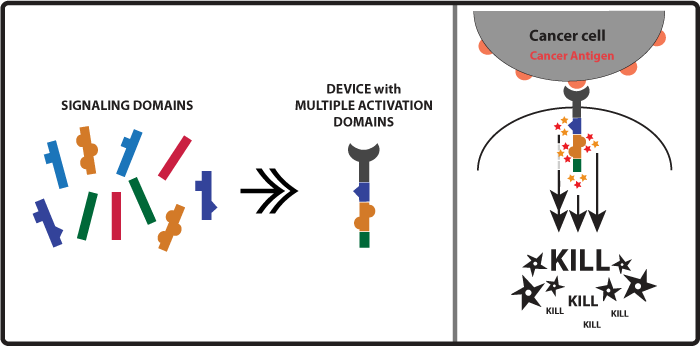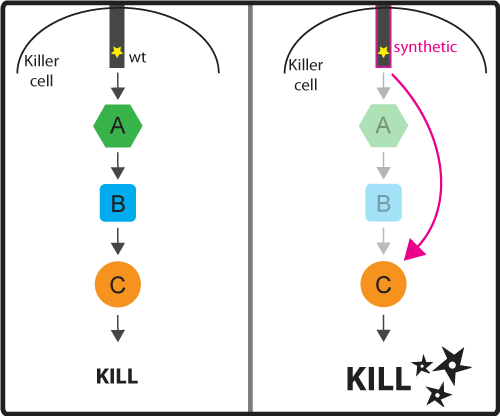Team:UCSF/Project/Signaling
From 2010.igem.org
Stronger Signaling
Goal: Engineer a stronger signaling response on killer cells that will lead to a more effective/faster elimination of the cancer cell.
Approach: After brainstorming during our team challenge we came up with three different approaches to achieve stronger signaling:
1. Co-stimulation by transfection of killer cells with a synthetic GPCR
2. Reengineer killer cell’s receptors to have multiple activation domains
3. Bypassing steps in the signaling cascade by engineering direct connections between the killer cell’s receptor and downstream effectors.
Devices:
1. Co-stimulation – we successfully used a device from last year’s UCSF team (registry part# BBA_K209400) and showed enhanced signaling activation
2. Multiple activation domains – we designed and constructed new devices for this approach but did not get to test them
3. Bypassing steps in activation cascade – we designed a few devices for this approach but did not had enough time to assemble them from parts to devices.
Brief Introduction
In this part of our project we wanted to create devices that made our synthetic cancer killers more effective than their natural counterparts at eliminating cancer cells by enhancing the activation mechanisms that lead to the killing response. Once our synthetic cancer killers confirmed they were in the presence of a cancer cell (using the devices developed in the GREATER PRECISION part of our project) they would take no time to eliminate it and could rapidly move on to the next target. Natural immune killers use receptor-associated intracellular activation domains to tell the inside of the cell that it needs to get ready to kill the cancer cell. This means that these intracellular activation domains, such as ITAMs (Immunoreceptor Tyrosine-based Activation Motifs), once activated recruit and activate kinases and a cascade of signaling events is initiated culminating in the formation of the immune synapse between the killer cell and the cancer cell. The killer cell then releases killing agents into the immune synapse that tell the cancer cell to apoptose (die!). We thought of three ways to improve the activation of the killer cell (described in more detail below): (1) Co-stimulation using a synthetic GPCR to enhance strength of killing response; (2) Engineer receptors with multiple activation domains to increase the level of activation; and (3) Bypass steps on the activation cascade to possibly improve speed of response.
1. Stronger killing by Co-stimulation with a synthetic GPCR
Concept, Experimental design and Results
One way we thought of enhancing the killing response was to increase the amount of kinases activated, as these seem to have a central role in the induction of killing on the killer cells. For that we looked into other receptors that once activated would also lead to the activation of kinases. Last year, the UCSF iGEM team used synthetic G protein-coupled receptors (GPCRs) to engineer immune cells to move (chemotax) towards new targets. In the future these synthetic cellbots would be able to detect specific chemicals released by tumors and move towards them more efficiently (for more info on this project please see UCSF iGEM 2009). GPCRs are activated by small molecule ligands instead of cell surface proteins. Because intracellular kinases are involved in chemotaxis, we hypothesized that the synthetic GPCRs used by the 2009 team that showed to mediate chemotaxis could possibly enhance the killing response by increasing the overall amount of kinases activated (Figure 1).
Figure 1
To determine whether a synthetic GPCR can enhance activation of killing response, we transfected T cells with a synthetic GPCR from last year’s team (part# BBA_K209400), that recognizes the small synthetic molecule called CNO. Initially we wanted to use a killing assay to measure the level of immune killer cell activation but unfortunately this assay did not work out (please click here for a detailed explanation). So to measure the level of activation of our T cells we used an assay that measures T cell activation through the production of interleukin 2 (IL-2). IL-2 is a signaling molecule that is expressed by activated T cells. In our assay non-transfected and transfected T cells were incubated with and without CNO (synthetic GPCR’s ligand). After incubation the levels of IL-2 produced (presence of IL-2 in supernatant) were measured by ELISA assay. You can see our results in the graph below. The first and second bars (from the left to the right) on the graph below represent non-transfected T cells that were in the absence or presence of CNO, respectively. The third and fourth bars represent the synthetic GPCR-tranfected T cells that were in the absence or presence of CNO, respectively. The data shows that T-cells transfected with synthetic GPCR and in the presence of CNO (ligand) show a higher level of activation. The results indicate that the use of a synthetic GPCR can increase killer cell activation, therefore achieving the goal of enhanced signaling.
Results Figure: Enhancing killer cell activation with a synthetic GPCR
A synthetic GPCR shown to mediate immune cell migration towards the ligand CNO (results of UCSF iGEM team 2009 project) was introduced to T cells as a potential way to increase the level of kinase activation. IL-2 production was used as a measure of T-cell activation. The results show that when in the presence of CNO, T cells transfected with the synthetic GPCR , have a higher level of activation than non-transfected T-cells.
Devices: We used a device from last year (part# BBA_K209400) that codes for the synthetic GPCR.
Future Application
Our experimental model suggests a synthetic biology approach to eliminate cancer cells more effectively. If we could engineer synthetic GPCRs that recognize small molecules secreted by cancer cells, we could make killer cells move faster to a cancer site (based on UCSF 2009 project results) AND once at the cancer site our synthetic killers would also be equipped to eliminate the cancer more efficiently. The additional kinase activation caused by the synthetic GPCRs would augment the normal activation signal to enhance the killing response of the killer cell.
2. Stronger Killing by Engineering receptors with multiple activation domains
Concept and Experimental design
As mentioned in the introduction above when killer cell receptors bind to cancer antigens their intracellular activation domains (such as ITAMs) get activated and lead to the activation of kinases. So another approach to increase the amount of kinases activated and ultimately enhancement of the killing response would be to activate more activation domains. A small input would lead to a amplified output. With this in mind our team came up with the idea of constructing receptors with multiple activation domains so when one receptor would become activated it would lead to the activation of a higher number of kinases (Figure 2). Examples of immune killer cell’s receptors activation domains are CD3zeta, FCRgamma, DAP10.
Figure 2
Using chimeric antigen receptors (CARs) as external sensors for the presence of specific antigens we built various receptors with possibly different degrees of amplification. Attached to the antigen receptor would be multiple intracellular activation domains such as CD3z,FCRgamma and DAP10. This increased number of activation domains allows for a stronger signal to be transmitted further into the cell from the binding of one ligand to the antigen receptor. The increased amplification of the activation signal should lead to a stronger response by killer cells to induce cytotoxicity.
Devices: We were able to build, but not test, the following devices:
CAR-CD3z-CD3z
CAR-DAP10-CD3z
CAR-DAP10-DAP10
CAR-FCRg-CD3z
CAR-FCRg-DAP10
CAR = chimeric antigen receptor scFv (single-chain antibody protein domain) from Milone lab at University of Pennsylvania. They gave us mouse anti-humanCD19 and anti-humanMesothelin plasmids for us to use as a PCR source for cloning. These antibodies were developed by Ira Pastan at NCI and Dario Campana at Saint Jude's.
NOTE: Although we have these devices ready to be tested we did not submit them to the registry of parts as they are not in this year’s required biobrick format. All these devices were built under biobrick standard RFC28 and not moved to pSB1C3 due to time constraints.
3. Stronger killing by bypassing steps in the activation signaling cascade
Concept and Design
As discussed in the introduction, the activation signaling cascade (or pathway) connect the input (activation by binding cancer antigen) with the ultimate output (cancer cell killing). These signaling cascades while effective at regulating the ultimate response by the killer cell, can be slow because once the ligand binds to the receptor, the signal has to pass through the long chain of molecules that make up the signaling pathway. We would like to engineer a possible faster pathway by bypassing certain intermediate steps of the pathway (for example regulatory steps). As a result, we would cut down on the number of steps needed to be taken before reaching the desired output (Figure 3).
Figure 3
One way to achieve bypassing steps of the signaling pathway would be to make devices with the receptor bound directly to a downstream effector of the activation pathway. In this way we could skip steps in the signaling process and reduce the amount of time it takes a killer cell to get ready to kill a cancer cell. We can visualize this process through the use of a simple, hypothetical signaling pathway consisting of the receptor and three activation pathway proteins, A, B and C. If the activated receptor signals to A which in turn signals to B which signals to C which causes cell killing, the process could be made much quicker if we could engineer the receptor to “talk” directly to C, skipping A and B entirely. The new signaling pathway would then have the receptor signal to C which causes cell killing. Obviously there are some drawbacks of this design such as loss of amplification by the signaling cascade. Still it would be interesting to see if the by “shortening” the signaling pathway we would loose some regulatory steps and lead to a “faster’ killing response by the killer cell.
Devices: We did not have the time to build any of the devices we designed during the team challenge for this approach.
References
1. Signaling pathways controlling cell polarity and chemotaxis.
Chang Y. Chung, Satoru Funamoto and Richard A. Firtel
TRENDS in Biochemical Sciences 2001 Sep;26(9):557-66. Review.
http://www.ncbi.nlm.nih.gov/pubmed/11551793
2. Chemotaxis: signalling the way forward
Van Haastert PJ, Devreotes PN
Nat Rev Mol Cell Biol. 2004 Aug;5(8):626-34. Review.
http://www.ncbi.nlm.nih.gov/pubmed/15366706
3. GPCRs signaling directly through Src-family kinases
McGarrigle D, Huang XY.
Sci STKE. 2007 Jun 26;2007(392):pe35. Review.
http://www.ncbi.nlm.nih.gov/pubmed/17595221
4. Engineering Signal Transduction Pathways.
Kiel C, Yus E, Serrano L
Cell. 2010 Jan 8;140(1):33-47. Review.
http://www.ncbi.nlm.nih.gov/pubmed/20085704
 "
"




